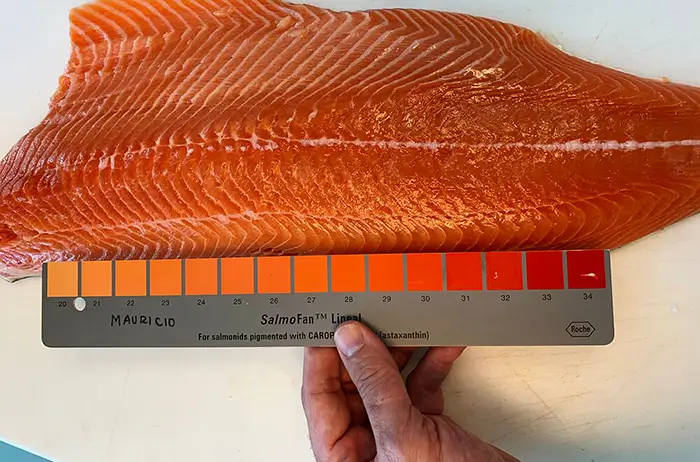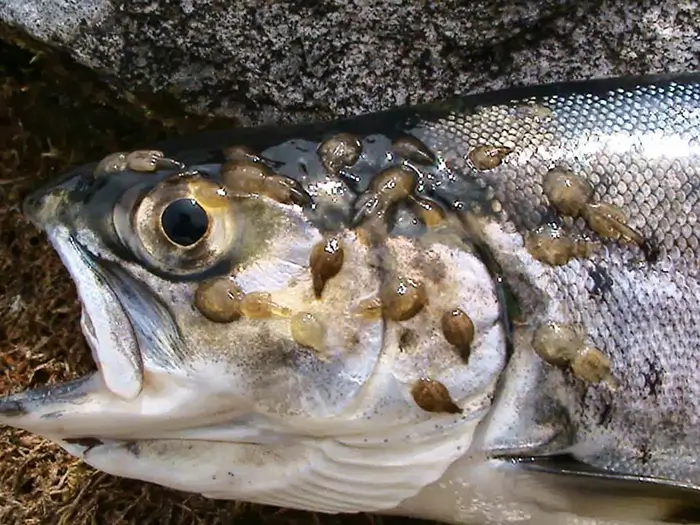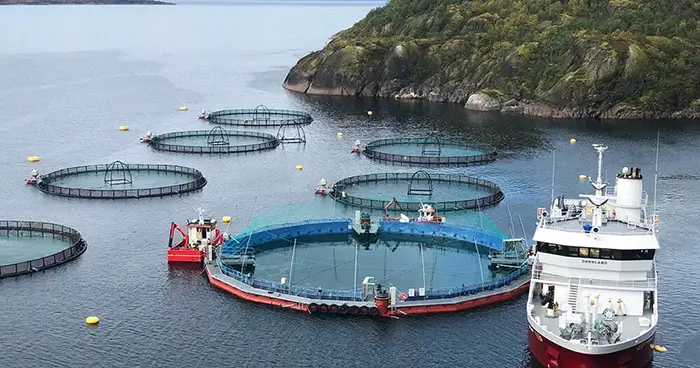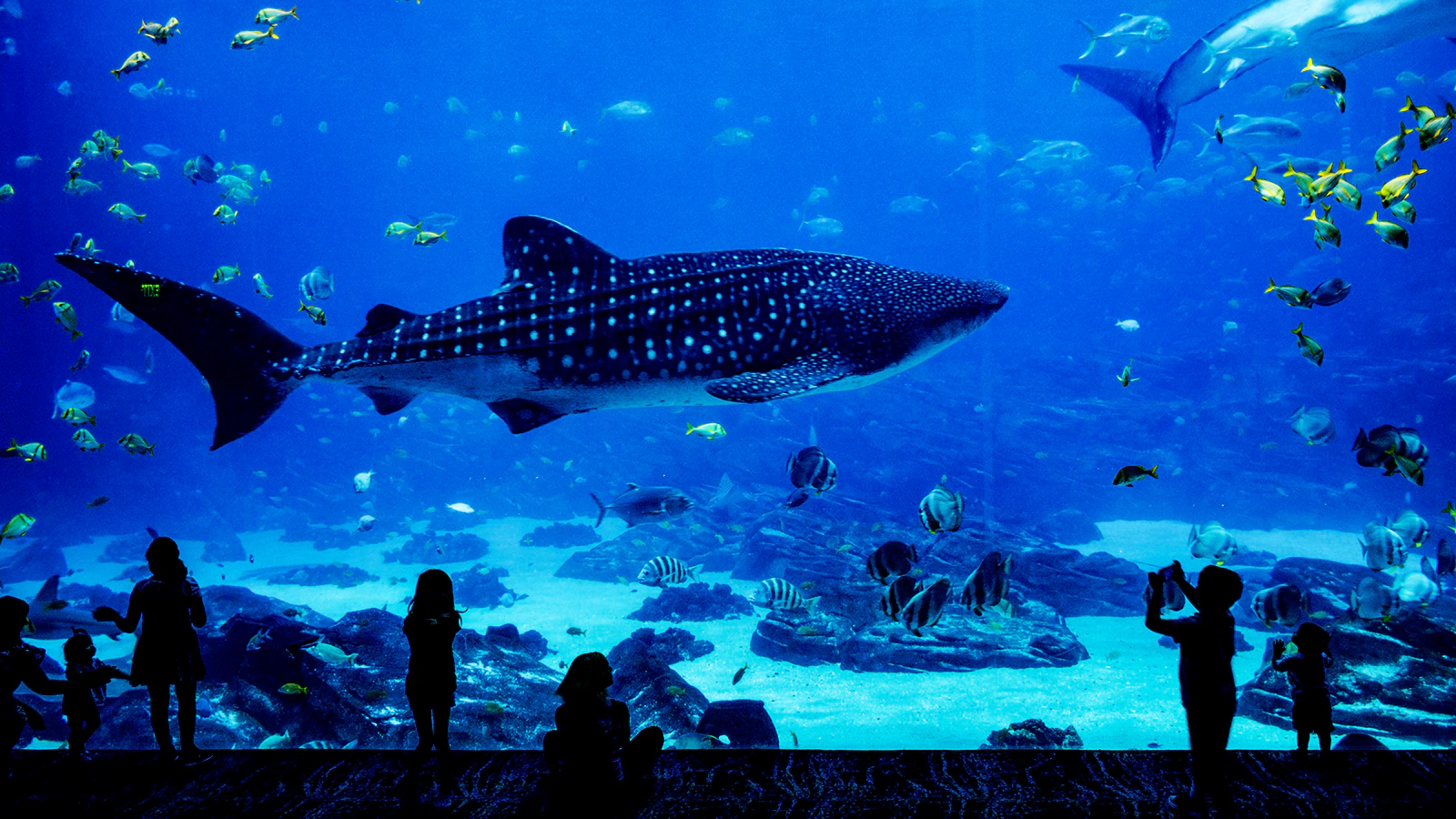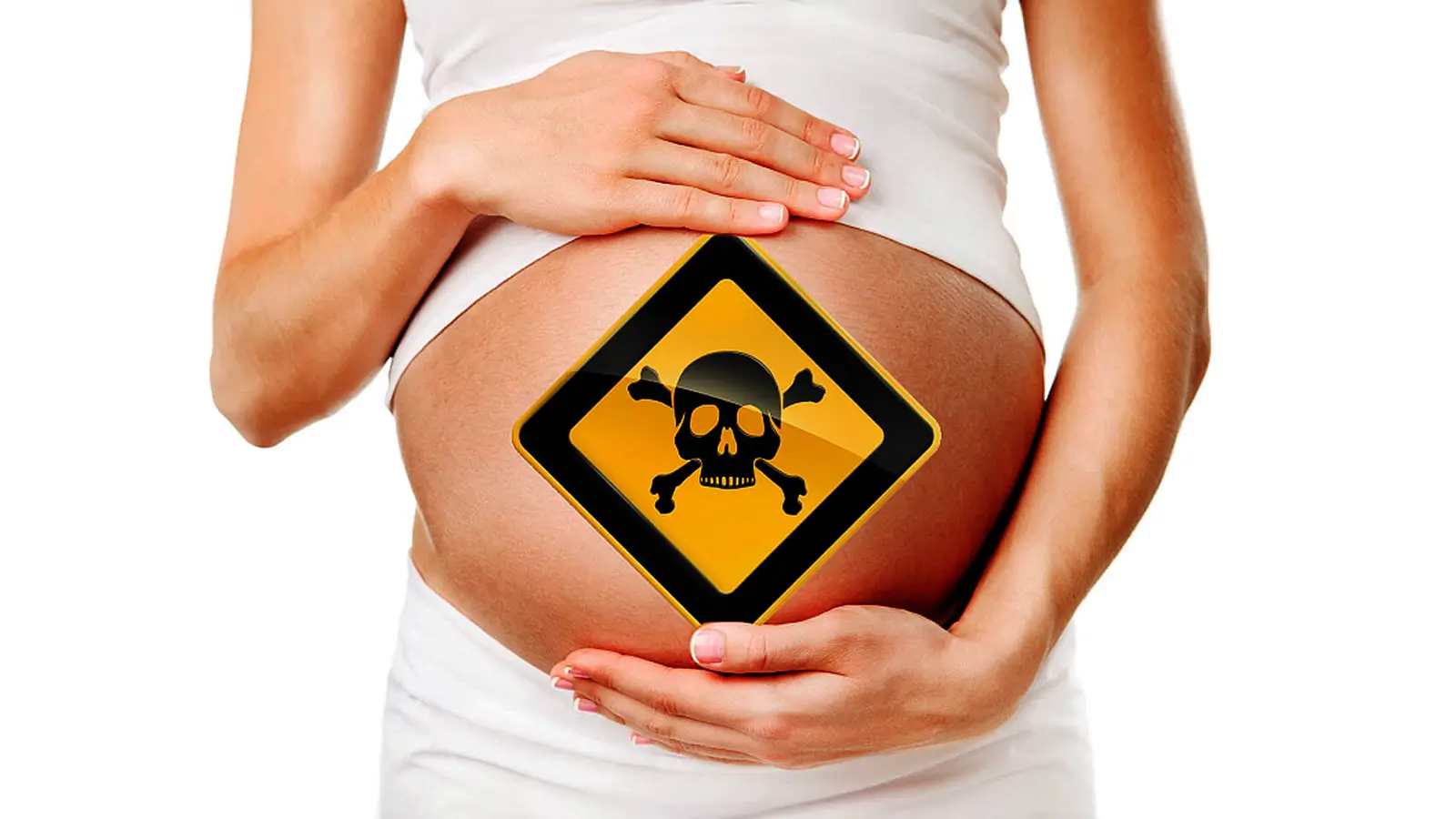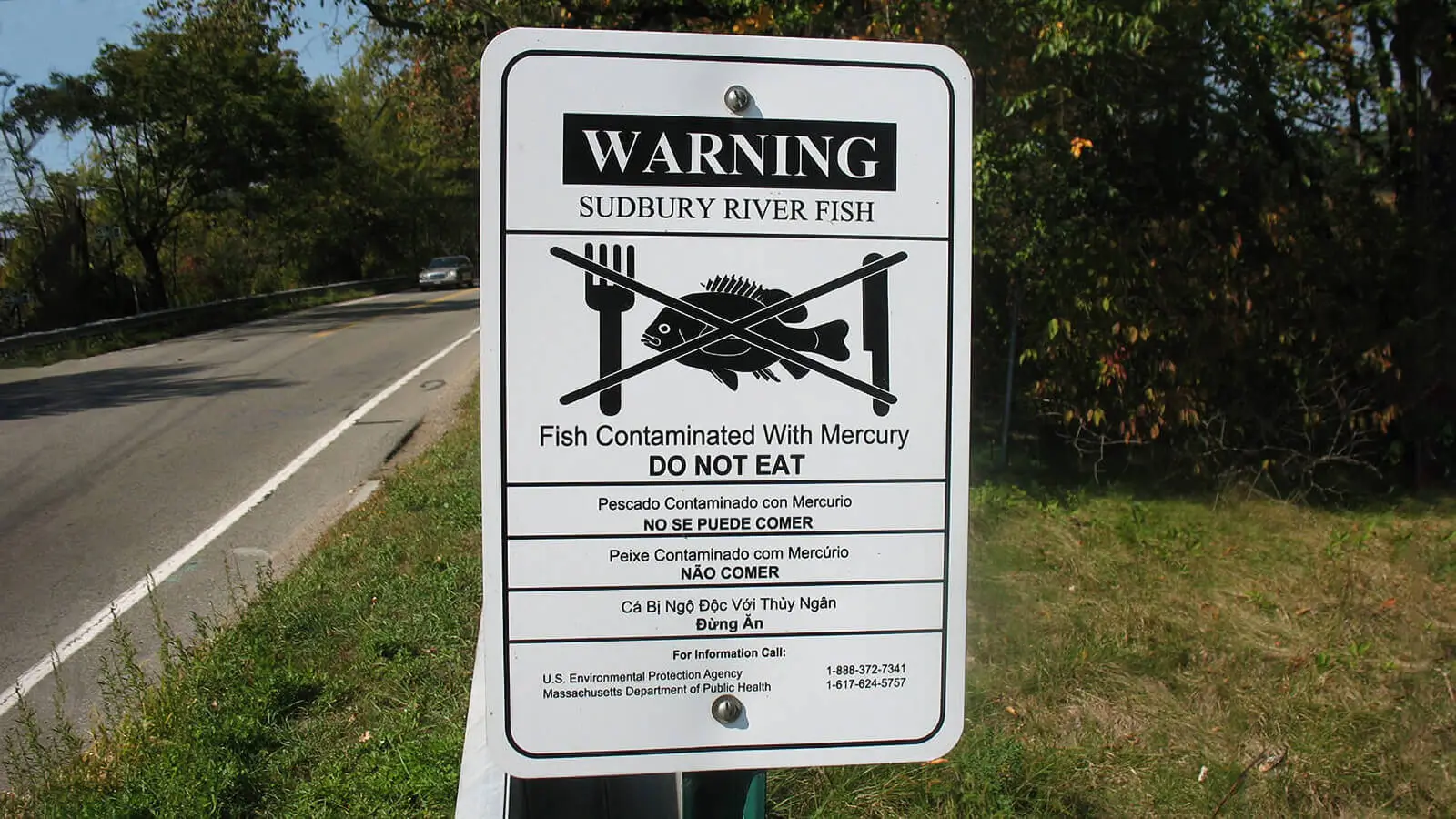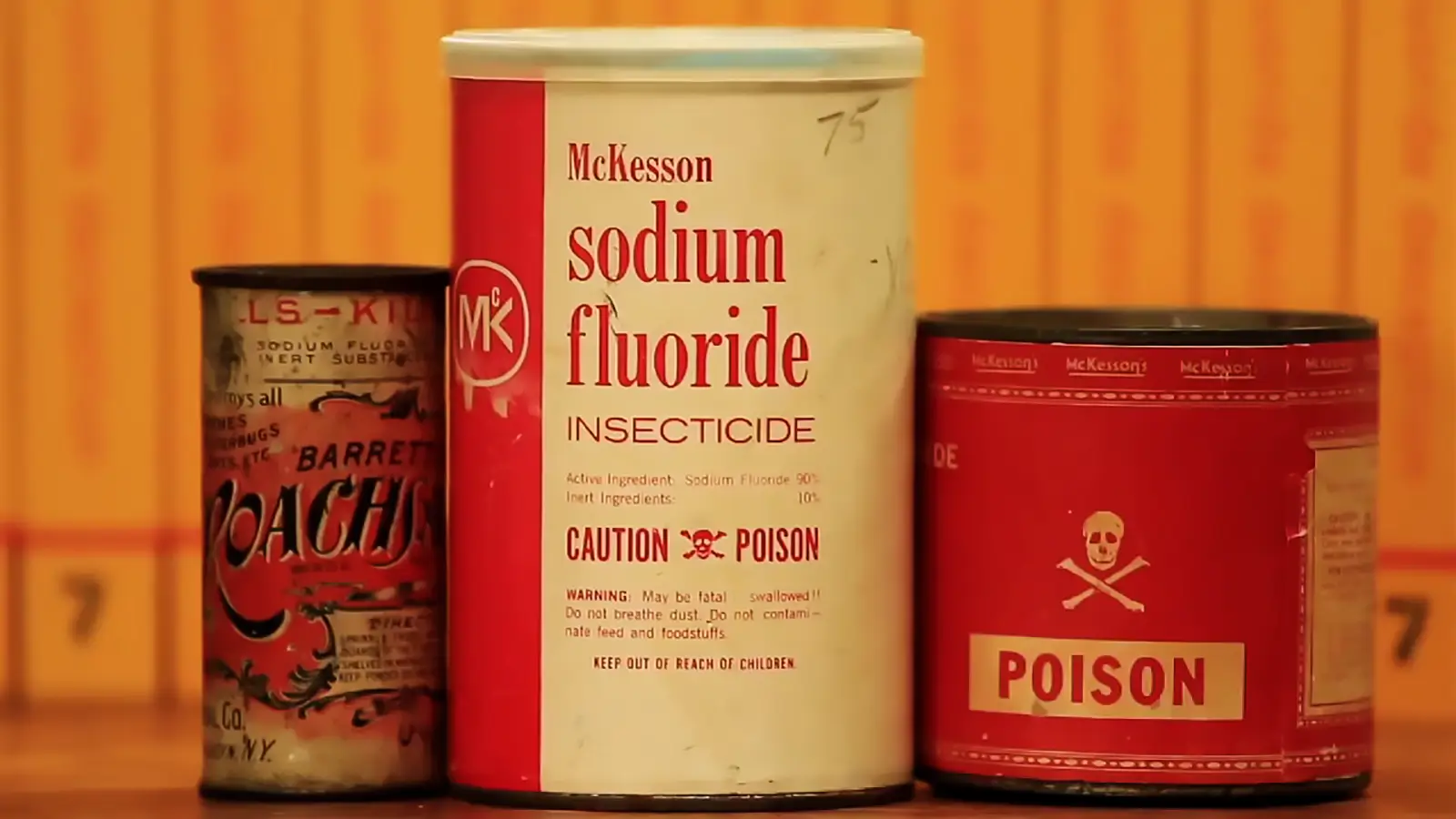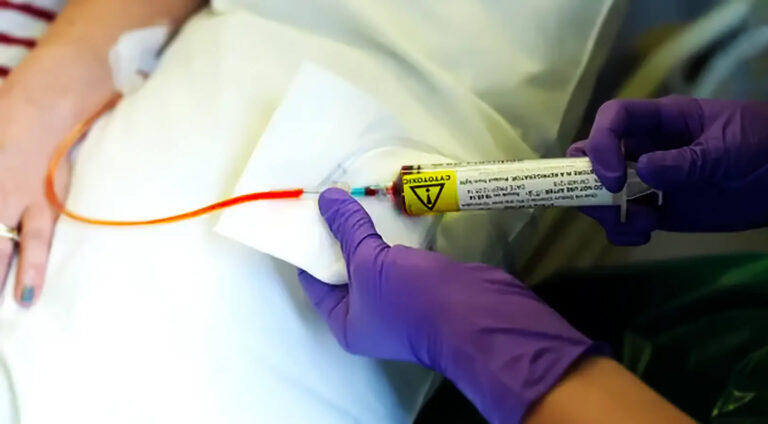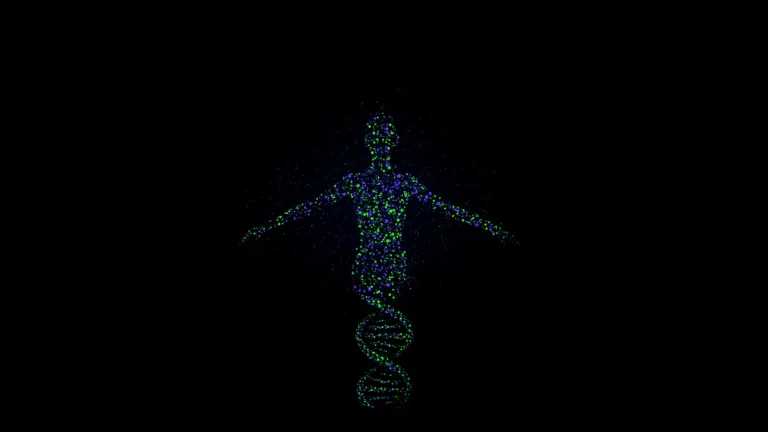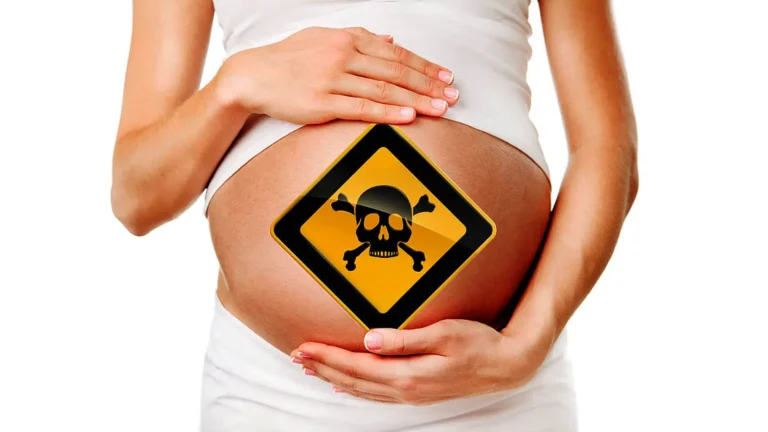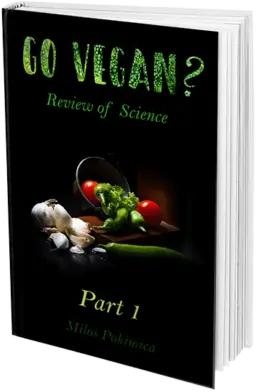養殖魚には最大10倍の汚染物質が含まれています。ワクチン接種後、魚には常に抗生物質と殺虫剤が投与されます。
ミロス ポキミカ
によって書かれた: ミロス ポキミカ
医学的に検証した結果 Xiùying Wáng, M.D. 博士。
Updated 6月 9, 2023魚介類や魚の需要が高まっていること、そして海全体で魚が枯渇しつつあるという事実のため、完全ではないにしても、原則としてほとんどが養殖魚になるでしょう。現在、魚全体の半数以上が養殖魚です。世界銀行は、2030年までに全魚介類の約3分の2が養殖されると推定している。最も一般的な養殖魚は、ティラピア、サケ、ナマズ、スズキ、タラです。
養殖魚には最大10倍の汚染物質が含まれています。
養殖サーモンのサンプルでは、野生サーモンと比較して8倍のレベル、市販の牛肉の4倍レベル、そして他の魚介類の3.5倍のレベルのPCBが含まれていることが示されています。いくつかの研究で、彼らは世界中の 700 以上のサケのサンプルを分析しました。これらの毒素のほとんどは魚の脂肪に蓄えられます。
狩猟肉と養殖動物の肉を比較する場合も同じです。
汚染物質の多くは養殖魚に与えられる餌に由来する。餌は他の家畜の餌と同じで、鶏肉や豚肉にPOPs(残留性有機汚染物質)が生物蓄積している場合、魚も同様ですが、魚は水槽に囲まれているため、魚が汚染物質を蓄積し始めるため、状況はさらに悪化します。水も同様に。
魚の排泄物や食べ残した飼料は、これらの養殖場の下の底に落ちて、腐敗し始めます。
平均的な規模のサケ養殖場では、人口 1 万人の都市の下水に相当する量の排泄物が排出されます。それは酸素を消費するバクテリアの繁殖地であり、酸素は海洋動物、特に貝類やその他の底生生物にとって不可欠です。また、 動物の排泄物自体が魚の餌として使用されます。
鶏は飼料から得られる栄養素の最大 30 パーセントしか使用しません。つまり、栄養素の70パーセントが糞の中に残っているということになります。魚はそれらの糞を食べ、残りのタンパク質、炭水化物、ビタミン、ミネラルをすべて吸収します。これらの糞も食べなければ落ちて底に沈殿します。その後、時間の経過とともに昆虫の幼虫が発生し、魚自身が排泄物からの汚染物質で満たされた幼虫を食べるようになります。それだけでなく、豚の排泄物の移送も一般的に行われています。 これは経済的に健全な設計手法として知られています。 畜魚一貫養殖。鶏、アヒル、豚から出る排泄物は、 養殖場に直接移される。ティラピアや鯉のような魚はプランクトンを主食としている。適量であれば、堆肥はプランクトンの成長を大幅に促進する。この魚のポンドの肥料化は、魚の成長と毒性レベルを劇的に改善する。.
なぜなら、養殖場では魚は野生の餌を食べず、足りない餌だけを食べるからです。 アスタキサンチン。アスタキサンチンは藻類からの赤い色素で、藻類が紫外線からの防御として使用し、最も強力な色素の 1 つです。 抗酸化物質 海洋生息地で。サーモンのピンク色や、たとえばピンクのフラミンゴのピンク色は、アスタキサンチンの摂取の結果です。ピンクのフラミンゴは生まれつき白です。養殖環境では、魚にはさまざまな栄養素が不足しています。 ファイトケミカル 海で自然に食べるため、染料が与えられています。養殖サーモンには定期的に染料が添加されています。ダイは、着色剤として使用される合成的に生成されたカロテノイド アスタキサンチンです。RocheのカロフィルピンクからBASFのルカンチンピンクまで、さまざまな色合いもあります。これらの染料は詐欺です。彼らには目的がありません。彼らの唯一の仕事は、消費者であるあなたをだまして、その製品が自然に見え、健康的で風味豊かであると思わせることです。
養殖廃棄物に加えて、これらの魚が混雑した環境に置かれているため、病気にもかかりやすくなります。 これは、感染症や寄生虫の温床となる通常の農業にたとえることができます。海では魚が散在しており、通常、感染は最小限のレベルで存在します。密集した海洋の飼育場では、病気や寄生虫が蔓延する可能性があります。これらの状況に対処するために、養殖魚にはミノーとしてワクチン接種が行われます。 ワクチン接種後、魚は常に抗生物質と殺虫剤を服用している。業界にとって最も重大な問題の 1 つは、 フナムシ。通常、野生ではまったく問題ありませんが、水槽ではまったく別の話になります。発生の最初の兆候が現れると、農家は飼料に大量の農薬を追加します。
魚の餌を与えられているため、オメガ3脂肪酸も不足しています。野生の魚は藻類からオメガ3を摂取します。魚の飼料は、粉砕した魚粉と植物性タンパク質を小麦などの結合剤の助けを借りて混ぜ合わせたものにすぎません。調査したすべての種類の魚において、オメガ 3 脂肪の量は天然魚の方がかなり多かった。一般に、養殖魚は安価で、天然魚よりも脂肪が10〜30%多く含まれています(そして、それはプロパガンダが吐き出すようなオメガ3脂肪酸ではなく、すでに過剰に摂取している脂肪にすぎません)。毒性のレベル、およびオメガ 3 のすべてが存在する場合はそれよりも低いレベル 酸。
解決策はクローズドシステムだ。水を処理し、再利用することで、近隣の野生生息地を汚染することはないが、そのような魚の生産方法ははるかに高価であり、野生の魚はそれだけで汚染されていることを忘れていた。その 清潔で汚染されていない魚は、それだけで炎症を起こす可能性が、ハンバーガーやポークベーコンよりもはるかに高いのです。また、それに加えて汚染もあります。
サーモンを食べることが健康に良いと思うなら、ベーコンを食べるのもいいかもしれません。養殖魚やエビはすべて毒です。エビやティラピアは最も汚いものの一つです。市場や店で見かけるエビやティラピアのほとんどは養殖場からのものです。
参考文献:
本からの抜粋ポキミツァ、ミロス ビーガンに行きますか?科学の復習パート 2. Kindle版、 アマゾン、2018年。
- Mo, Wing Yin et al. “Use of food waste, fish waste and food processing waste for China's aquaculture industry:ニーズと課題”.” トータル環境の科学 巻。613-614 (2018): 635-643。 土井:10.1016/j.scitotenv.2017.08.321
- ドレア、ホセ G.「動物飼料中の魚粉と、持続的な生体蓄積性および有毒物質への人間の曝露。」 食品保護ジャーナル 巻。69,11 (2006): 2777-85。 土井:10.4315/0362-028x-69.11.2777
- コスタ、ルシオ G. 「魚の汚染物質: リスクと利益の考慮事項」 労働衛生と毒性学のアーカイブ 巻。58,3 (2007): 367-74。 土井:10.2478/v10004-007-0025-3
- Cabello、Felipe C. 「水産養殖における予防的抗生物質の多量使用: 人間と動物の健康、そして環境にとってますます問題となっています。」 環境微生物学 巻。8,7 (2006): 1137-44。 土井:10.1111/j.1462-2920.2006.01054.x
関連記事
栄養と健康について何か質問はありますか?
ぜひご意見をいただき、次回の投稿でお答えしたいと思います。皆様のご意見とご意見に感謝しており、すぐにご連絡をお待ちしております。私もあなたを招待します フォローする Facebook、Instagram、Pinterestでダイエット、栄養、健康に関するコンテンツをご覧ください。そこにコメントを残して、他の健康愛好家とつながり、あなたのヒントや経験を共有し、私たちのチームやコミュニティからサポートや励ましを得ることができます。
この投稿があなたにとって有益で楽しいものであり、学んだ洞察を生かす準備ができていることを願っている。この投稿が役に立ったと思われた方は シェアする 友人や家族など、その恩恵にあずかれるかもしれない人たちと一緒に。誰が健康の旅にガイダンスやサポートを必要としているかわからないのですから。
– あなたはおそらくそれも好きでしょう –

栄養について学ぶ
ミロス・ポキミカは、自然医学の医師、臨床栄養士、医療健康と栄養のライター、栄養科学アドバイザーです。書籍シリーズの著者 ビーガンに行きますか?科学の復習また、自然健康サイト「GoVeganWay.com」を運営している。
医療上の免責事項
GoVeganWay.com では、最新の栄養と健康関連の研究のレビューをお届けします。提供される情報は著者の個人的な意見を表すものであり、専門的な医学的アドバイス、診断、または治療に代わることを意図または暗示するものではありません。提供される情報は情報提供のみを目的としており、資格のある医師または医療提供者の相談、診断、および/または治療に代わるものとして機能することを意図したものではありません。GoVeganWay.com で読んだことや GoVeganWay.com を通じてアクセスしたことを理由に、専門家の医学的アドバイスを無視したり、医療治療を受けるのを遅らせたりしないでください。
認可された医師に相談する前に、GoVeganWay.com で読んだ内容の結果としてライフスタイルの変更や変更を決して適用しないでください。
医療上の緊急事態が発生した場合は、直ちに医師または 911 に電話してください。GoVeganWay.com は、内部で言及されている特定のグループ、組織、検査、医師、製品、手順、意見、またはその他の情報を推奨または承認しません。
編集者のおすすめ –
ミロス・ポキミカは健康・栄養ライターであり、栄養科学アドバイザーである。書籍シリーズの著者。 ビーガンに行きますか?科学の復習また、自然健康サイト「GoVeganWay.com」を運営している。
最新記事 -
トップヘルスニュース — ScienceDaily
- Scientists find dark chocolate ingredient that slows aging12月 12, 2025 に
Scientists have uncovered a surprising link between dark chocolate and slower aging. A natural cocoa compound called theobromine was found in higher levels among people who appeared biologically younger than their real age.
- Nerve injuries can trigger hidden immune changes throughout the entire body12月 12, 2025 に
Researchers discovered that nerve injuries can alter the immune system throughout the body, and males and females react very differently. Male mice showed strong inflammatory responses, while females showed none, yet both transmitted pain-inducing signals through their blood. These findings reveal previously unknown pathways driving pain, especially in females. The work points toward new opportunities for personalized chronic pain therapies.
- NAD+ supplement shows early promise for long COVID fatigue and brain fog12月 12, 2025 に
Long COVID still affects people worldwide with stubborn symptoms like fatigue and cognitive issues. A clinical trial tested whether boosting NAD+ using nicotinamide riboside could help. Although overall group differences were limited, many participants showed encouraging improvements after taking NR for at least 10 weeks. The findings suggest NAD+ enhancement may offer symptom relief for some individuals.
- Stressed rats keep returning to cannabis and scientists know why12月 11, 2025 に
Rats with naturally high stress levels were far more likely to self-administer cannabis when given access. Behavioral testing showed that baseline stress hormones were the strongest predictor of cannabis-seeking behavior. Lower cognitive flexibility and low endocannabinoid levels also contributed to increased use. The results hint at possible early indicators of vulnerability to drug misuse.
- Even moderate drinking carries a bigger cancer risk than you think12月 11, 2025 に
Researchers found that both how often and how much someone drinks significantly shape their cancer risk, even at moderate levels. Vulnerability varies across groups, with genetics, socioeconomic status, obesity, and lifestyle behaviors amplifying harm. The review also uncovered gender differences, beverage-specific risks, and biological pathways that intensify cancer development.
- Scientists uncover a hidden protein behind deadly mystery diseases12月 11, 2025 に
Scientists discovered that the protein RPA plays a critical and previously unconfirmed role in stimulating telomerase to maintain long, healthy telomeres. When RPA malfunctions, telomeres can shorten dangerously, leading to serious diseases.
- Gene-edited CAR-T cells erase aggressive T-cell leukemia12月 11, 2025 に
A cutting-edge therapy using base-edited immune cells is offering a major breakthrough for patients with one of the toughest forms of blood cancer, T-cell acute lymphoblastic leukaemia. By precisely rewriting tiny sections of DNA, scientists at UCL and Great Ormond Street Hospital created universal CAR T-cells capable of targeting the cancer without harming themselves—a long-standing challenge in T-cell–based therapies. Early trial results show deep, long-lasting remissions, including in […]
パブメッド、 #ビーガンダイエット –
- Healthful and Unhealthful Plant-Based Diets and Their Association with Cardiometabolic Targets in Women Diagnosed with Breast Cancer: A Cross-Sectional Analysis of a Lifestyle Trial12月 11, 2025 に
CONCLUSIONS: Maintaining cardiometabolic risk factors within normal ranges is clinically relevant in BCS, and this may be more likely when a plant-based diet is consumed, especially if low in unhealthy plant foods.
- Dietary and Lifestyle Patterns and Their Associations with Cardiovascular and Inflammatory Biomarkers in Vegans, Vegetarians, Pescatarians, and Omnivores: A Cross-Sectional Study12月 11, 2025 に
Background: Plant-based diets are associated with reduced cardiometabolic risk, yet the influence of lifestyle behaviors on these benefits remains insufficiently understood. Objective: To assess the combined impact of dietary patterns and lifestyle behaviors on body composition, lipid profiles, and inflammatory biomarkers in healthy young adults. Methods: In this cross-sectional study, 155 participants aged 18-39 years were categorized into four dietary groups: vegans (n = 48), vegetarians (n […]
- Functional and Nutritional Properties of Lion’s Mane Mushrooms in Oat-Based Desserts for Dysphagia and Healthy Ageing12月 11, 2025 に
Hericium erinaceus (Lion’s Mane mushroom) is a medicinal species recognised for its neuroprotective and antioxidant properties. This study investigated its potential as a functional ingredient in oat milk-based desserts formulated for individuals with dysphagia. Freeze-dried Lion’s Mane powder (LMP), containing high-quality protein (~16%, amino acid score 88%), dietary fibre (~31%), and phenolic compounds (72.15 mg GAE/g), was incorporated at varying levels using gelatin or iota-carrageenan […]
- “A football team with no midfield”: A qualitative analysis of anti-vegan stigma in Italy12月 7, 2025 に
A growing body of research has demonstrated the prevalence of unfavourable attitudes towards individuals who adhere to a vegan diet and has provided empirical evidence to support the existence of an anti-vegan ideology. The present study aims to contribute to extant knowledge by examining the social perception of veganism and vegans in Italy. Italy is a nation characterised by a traditional culture of food that serves as a significant catalyst for collective identification and national pride….
- Plant-based dietary index on the Mediterranean and a vegan diet: a secondary analysis of a randomized, cross-over trial12月 5, 2025 に
CONCLUSION: These findings suggest that, replacing animal products even with the “unhealthful” plant-based foods on a vegan diet was associated with weight loss.
ランダムな投稿 –
おすすめの投稿 -

PubMed の最新情報、 #植物ベースの食事 –
- Bioactive Nutritional Components Within the Planetary Health Diet for Preventing Sarcopenic Obesity and Diabetic Sarcopenia: A Systematic Reviewby Lia Elvina 12月 11, 2025 に
CONCLUSIONS: PHD-aligned foods combining plant proteins, polyphenols, and fermented products strengthen nutrient sensing, mitochondrial efficiency, and cellular resilience, representing a sustainable nutritional framework for preventing and managing SO and DS.
- Ultra-Processed Foods Consumption, Mediterranean Diet Adherence and Sociodemographic Correlates in an Italian Adult Population: The UFO Surveyby Emilia Ruggiero 12月 11, 2025 に
Background: Although national surveys report increasing ultra-processed foods (UPFs) consumption, updated estimates for Italy are lacking. Given the central role of the Mediterranean Diet (MD), understanding how UPFs contribute to the contemporary Italian diet is essential. This study quantified UPF intake in a convenience sample of Italian adults and examined its main sociodemographic correlates, including MD adherence. Methods: A web-based cross-sectional survey was conducted among Italian…
- High-Salt Diets, Intestinal Barrier, and Hypertension: A Mechanistic Review and the Promise of Dietary Therapyby Wenhao Si 12月 11, 2025 に
Hypertension is a major public health problem worldwide, and high-salt diets are one of the main causes of hypertension. The intestinal mucosal immune system is the largest immune organ in vertebrates. Hypertension was associated with increased intestinal permeability and an inflammatory state. The bacterial communities attached to the intestinal mucosa played a significant role in the development and maturation of the autoimmune system, as well as inflammation and immunity to disease. In […]
- Health-Promoting Potential of the Mediterranean Diet and Challenges for Its Application in Aging Populationsby Marta Cianciabella 12月 11, 2025 に
The Mediterranean Diet (MD) is a lifestyle that involves not only dietary habits, well known for their effectiveness in preventing health risks by supplying well-balanced foods rich in bioactive compounds, but also daily habits that improve the quality of life. Older adults represent a segment of the population that can particularly benefit from this dietary pattern. However, the specific characteristics and needs of older individuals require a critical analysis of aspects that may limit…
- Association of Mediterranean Diet Scores with Psychological Distress in Pregnancy: The Japan Environment and Children’s Studyby Yuri Takahashi 12月 11, 2025 に
Background/Objectives: Perinatal mental disorders are important health issues that affect both mothers and their children. The Mediterranean diet (MD) is one of the most well-recognized healthy dietary patterns worldwide. Recent evidence suggests that MD may prevent or reduce the risk of perinatal mental disorders. This study investigated the association between MD adherence during pregnancy and psychological distress in a large cohort of Japanese births. Methods: Data were obtained from […]
- Protective Role of Ginsenoside F1-Enriched Extract (SGB121) in Metabolic Dysfunction-Associated Fatty Liver Disease (MAFLD)by Bo Yoon Chang 12月 11, 2025 に
Introduction/Objectives: Ginsenoside F1, a pharmacologically active saponin derived from Panax ginseng, exhibits diverse bioactivities, but its use is limited because it is difficult to purify and has high production costs. To overcome these challenges, a ginsenoside F1-enriched extract named SGB121 was developed. This study aimed to evaluate the therapeutic efficacy of SGB121 in a high-fat, high-carbohydrate (HFHC) diet-induced metabolic dysfunction-associated fatty liver disease (MAFLD) […]
